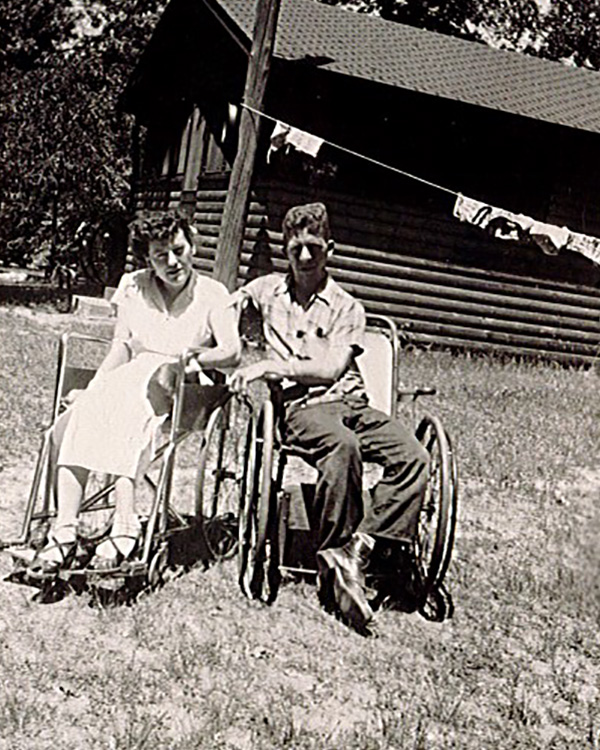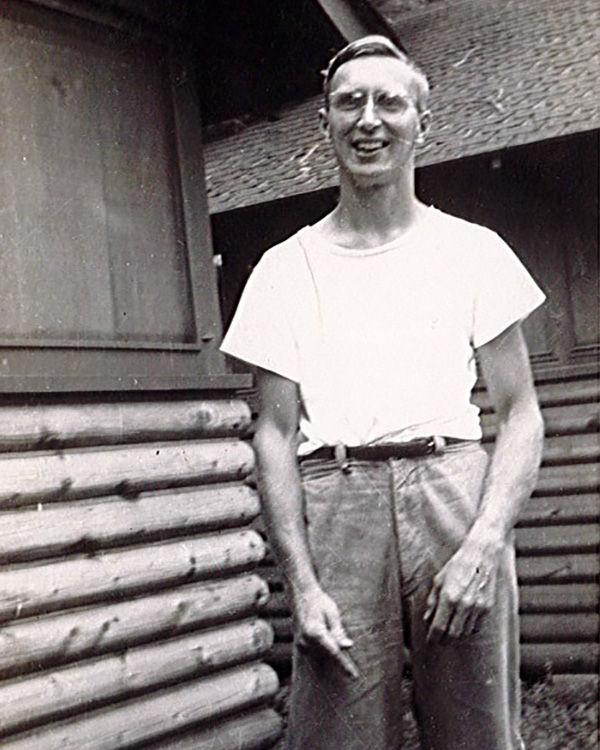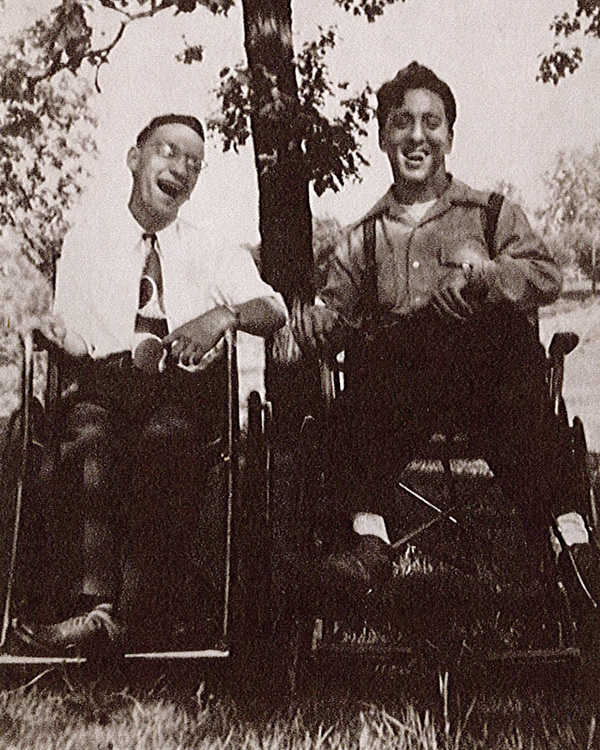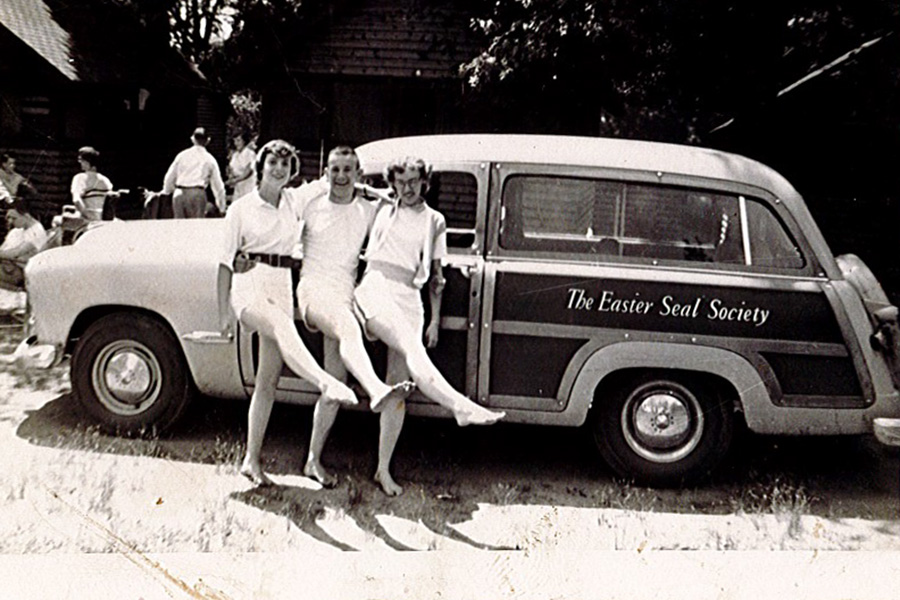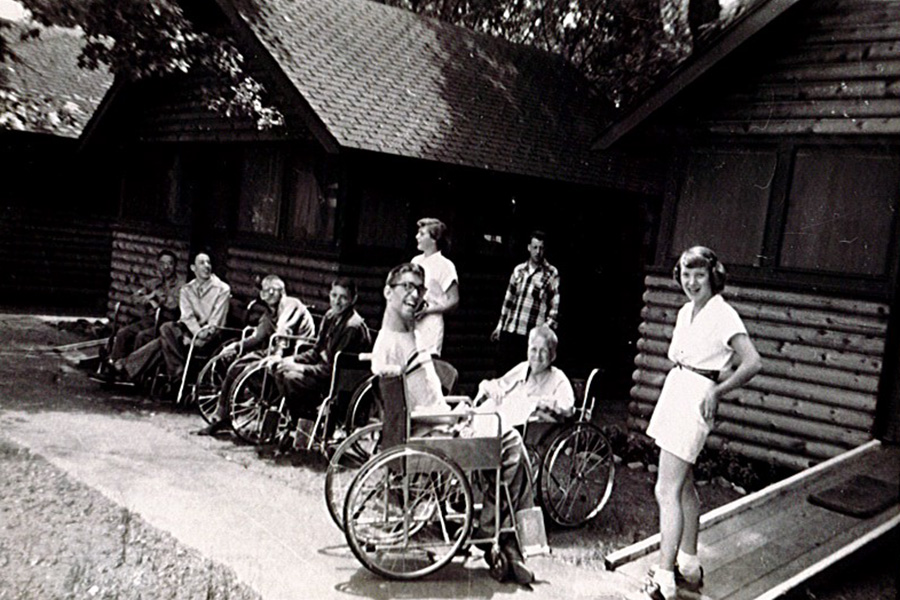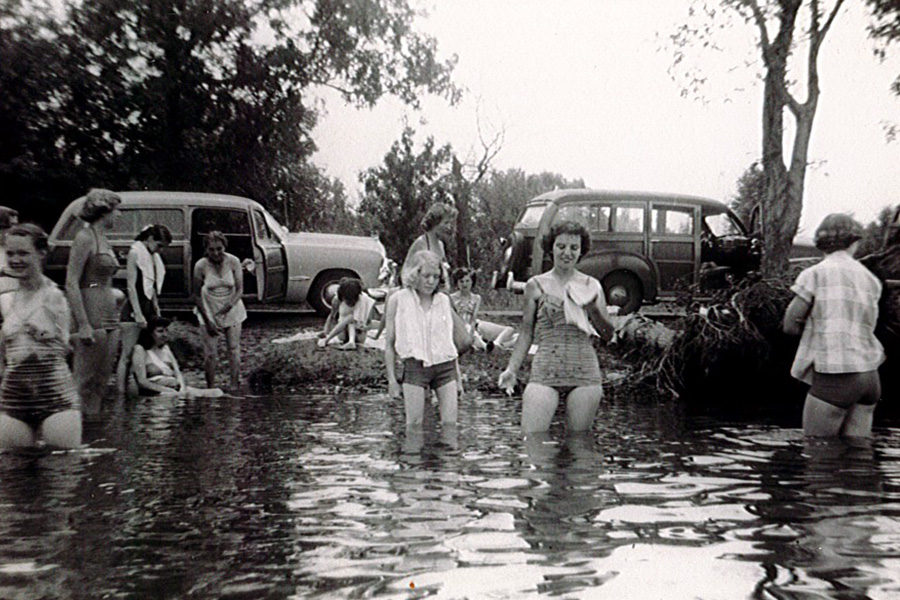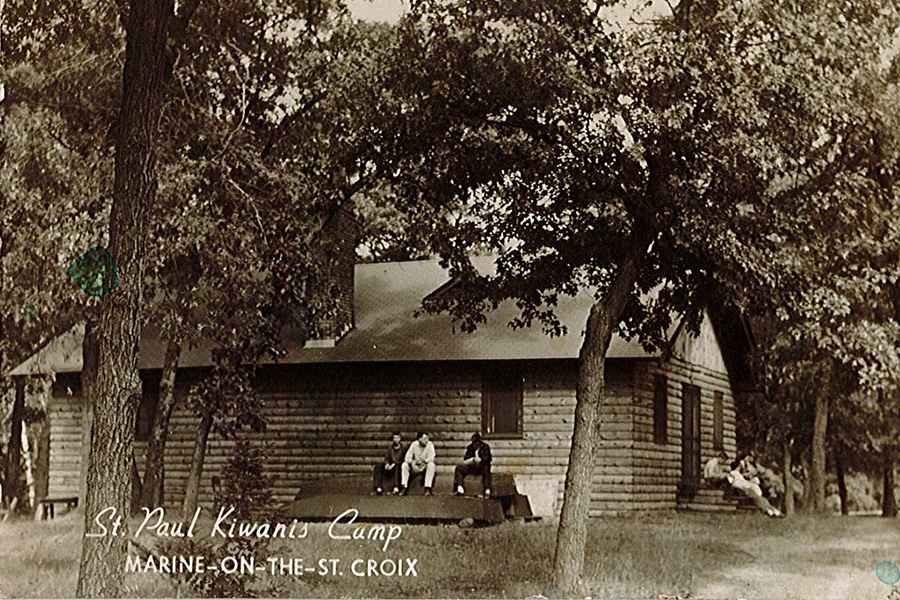A Brief History of True Friends Camp Courage
Dr. Bob and Sue Erickson met at Camp Courage during the first year of camp (1955/1956) where they both worked as camp counselors. Sue's maiden name was Jambeck and she is the daughter of the late Toy Jambeck, who was the first director of Camp Courage. Bob and Sue's wedding was the first one performed at Camp Courage. They have been passionate supporters of Camp Courage and in recent years have been dedicated to sharing the history of Camp Courage and its importance to people with disabilities and those who worked at the camps in its early years.
What follows is an early film and photos of a bygone era – a time when access to recreation and nature by people with disabilities was in its infancy. More information about the growth and development of Camp Courage and True Friends will be added when it becomes available.
Disclaimer: Due to the historical nature of this film and related content, it contains archaic language when referring to individuals with disabilities that do not align with the current language standards of True Friends. True Friends believes in using person-first language where we focus on the individual as a whole and understand that a disability is only one part of the whole person.
(Nostalgic music)
(Birds chirping)
[Narrator] Dear Mom, I have a little time so I thought I'd write you a few lines.
I've been very busy, but also very happy.
I'm especially happy for the crippled children here, mom, because the wonderful new outlook they get at Camp Courage truly becomes for them, their strongest crutch.
(whimsical music)
The whole program here at the camp is designed to help cripple children take the plunge to get into the swim of life.
Self-confidence makes a big difference in the outlook of a handicapped person, and the children gain a lot of it here at Camp Courage.
The companionship of other boys and girls with similar problems plays a big part in developing healthy attitudes. The relationship between the child and his counselor also builds up the child's confidence.
To the child, the counselor is a special friend, an understanding, congenial guardian, always near at hand, always ready to instruct, comfort, guide and assist.
I wish you could see this camp for yourself, mom. It's really beautiful. There are 40 acres of land here on Cedar Lake, just a few miles from Annandale and Maple Lake, and about 45 miles from Minneapolis.
Each two week summer session is a beehive of activity in an attractive and cheerful setting. We keep the youngsters plenty busy, and they love every minute of it.
Crippled children come here from all parts of Minnesota. From Deep River Falls and Duluth, from Bemidji and Bird Island, from Luverne and Caledonia.
But no matter where they come from, they all have the time of their lives at Camp Courage. After all, crutches and wheelchairs are really no help without a positive attitude to go with them. That's why we say the right attitude is their strongest crutch.
It's this inner strength that we try to help them find at Camp Courage.
You're likely to see almost any type of handicap here. Some of the children have had polio or cerebral palsy. Others have had muscular dystrophy or arthritis. Still, others are amputees. Either they had accidents, or were handicapped at birth.
But no matter what the handicap, this (indistinct) gives these children a chance to enjoy the favorite recreations of all children. To do the things all children want to do, to play games, swim, go boating and canoeing, fish, hike, study nature, do craft work, and take part in many, many other activities.
In their own communities, these children may find themselves alone with their handicap, with wheelchairs and crutches as their constant companions, but here at camp through sharing their experiences with others like themselves, they get a real sense of belonging.
They are not alone.
Their activities are carefully planned and carried out by the camp director and his staff.
As counselors and therapists, we have a very satisfying job. There are more than 40 of us to carry out the program, which calls for close supervision of the children at all times.
(bright music)
Waterfront activities are the number one item at Camp Courage, and swimming tops them all. The children really look forward to this.
(whimsical music)
Not only is swimming a lot of fun, it's also the perfect exercise for arms and legs that don't work just right.
(bright music)
(whimsical music)
Nothing can so quickly create a strong friendship between camper and counselor, as a happy session in the water. The campers are in the water every chance they get, learn to float, kick, and swim and I learn to swim.
They also build self-confidence, for they learn that they can do things many thought were impossible.
(bright music)
The shiny red and yellow water bike was also a gift.
One of the biggest thrills is a ride on one of the pontoon boats. They're wonderful for fishing and for rides across the lake for cookouts, and if a camper is pretty much confined to a wheelchair we just roll it right onto the pontoon boat.
Many of these children have never had a boat ride before.
(bright music)
All of these waterfront activities are important.
I know one boy who saved his dad's life because of his swimming training here. This, despite the fact he was paralyzed from the waist down by polio.
The wonders of nature make a lasting impression on the children, and the nature study lodge is a very popular place. Here they can learn about the insect world, get acquainted with all sorts of living wildlife.
The aquarium is always an attraction. So is the seashell collection.
Outdoor nature, jaunts and even overnight hikes are planned by the staff, with supervised nature study always a part of the fun. Even the lowly toad finds admiring friends at Camp Courage, and the turtle too.
The activities are pretty much like those at any other camp, except that the children do things a little bit slower. They can be very determined when they set their minds to do something.
Mission accomplished.
It takes a steady aim when you're on the archery range. And believe me, there's a real gleam in a camper's eyes, when she hits the target.
(bright music)
The children are always having fun. Take Indian Day for instance, everybody becomes an Indian for a day and they really whoop it up. They go roaming all around the camp for hidden Indian treasures, usually for prizes, candies, and other treats. They hold big powwows, and war dances, and their songs and laughter are a wonderful thing to hear.
(bright music)
And of course, there's baseball.
These boys are no different than any others when it comes time to say," Batter up," they pitch, and they bat as if the World Series were at stake.
There just isn't time to think of handicaps at a time like this.
But no matter the mood from frenzied sport to lazy contemplation, our young camper can be a philosopher too.
He hardly suspects that here he is finding his strongest crutch, but even philosophers must eat and when the dinner (indistinct), no coaxing needed.
Each in his own way says grace.
Good food and plenty of it.
Matter of fact, I'm gaining weight, which I worry about, incidentally.
Talk about a vanishing act, I've never seen food disappear so fast.
Outdoor eating is popular, too. Short hikes to out of the way places for picnic lunches often bring about lifelong friendships.
Everybody pitches in.
The milk case arrives, lunch is eaten, and then there's time for song, and happy chatter.
These are the moments that will be cherished memories tomorrow.
All too soon, it's time for the hike back to camp.
Campfire cookouts are also part of the daily program.
Another busy place is the arts and crafts building. Here, the children do all sorts of handy work.
(bright music)
Some get really good at such things as basket weaving, leather work, metalwork, clay modeling, and many others.
Creative ideas take many forms, with craft instructors always at hand for guidance.
During rest hour, the children return their cabins, their home away from home while at camp.
Up to 16 youngsters, with four counselors occupy each building. They total 450 campers each summer.
The interiors are modern, with complete facilities.
The tall peaked roofs add a distinctive touch to the beauty of the camp.
(bright music)
And from each of the cabins, a bright beautiful view of the lake.
The health and therapy center houses the nurse's quarters and an infirmary. A nurse is always on duty, and a physician who examines the children on arrival is on call at all hours.
The same building is headquarters for physical and speech therapy. A trained physical therapist works with the children.
Learning to walk in the parallel bars is one of the important exercises.
Muscle stretching is another.
Incidentally, such therapy is typical of the equipment made possible at the rehabilitation centers in various parts of Minnesota.
Wheelchairs, as well as many other types of equipment, such as hospital beds, portable lifts, and walkers, are distributed to handicapped persons throughout the state each year.
Instill another (indistinct).
A family doctor who examines each child before he comes to camp may recommend therapy for him during his stay.
In the speech therapy room, another therapist helps a child to talk better. Various games and drills are used. Simple breathing exercises and hearing tests are just part of the help given a child to improve his speech.
Still other specialists include an occupational therapist, who trains the youngster in simple, everyday tasks such as using a spoon, buttoning dress, or buckling a belt. Parents are extremely grateful for this training.
Everything possible for the convenience of the handicap has gone into the design of Camp Courage. Special ramps help the youngsters go from one floor to in spacious dining hall, recreation center.
Even blind children can enjoy the benefits of camping life. There's something special about a blind girl learning the feel and smell of a cedar tree, or learning to swim, or just having the companionship of counselors and other youngsters.
Their stay at Camp Courage is a happy, never to be forgotten, experience that plays a big part in bringing to these children that big change in attitude.
Here in the cathedral beauty of Minnesota's great outdoors, it is fitting that a handicapped child may worship in a lovely woodland setting. The chapel at camps has a natural birch bowl named after the opera star, Marjorie Lawrence, who herself conquered a severe handicap.
Camp Courage opens its arms to youngsters of all faiths. The camp rosters include children of many creeds, and the spiritual needs of all are considered in planning the various religious services.
Here at Camp Courage, translated each year into big things for hundreds of crippled children.
Things many of us too easily take for granted, but the kind of things we must not take for granted in the life
of a crippled child.
Beneath the bustle of gay activity at Camp Courage, lies a deep and serious urgency.
The fun they find here is not an end in itself.
It is, but the opening of a door for young hearts seeking a way into our adult world. They like all who must struggle against unwanted helplessness, need all the love and understanding and help that we who are more fortunate can give them.
Well Mom, I could write much more, but it's time for the swimming session and I see the girls are waiting. That happy glow in their faces is all I need to realize how important my counselor work is. It reflects the wonderful new outlook they get at Camp Courage.
That gives greater meaning to their lives.
As well expected, they teach us at camp to use what we have machined of it.
It is this brave new outlook, Mom, which means so much to these crippled children.
It is their hope for the future.
Truly.





